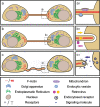The art of cellular communication: tunneling nanotubes bridge the divide
- PMID: 18386044
- PMCID: PMC2323029
- DOI: 10.1007/s00418-008-0412-0
The art of cellular communication: tunneling nanotubes bridge the divide
Abstract
The ability of cells to receive, process, and respond to information is essential for a variety of biological processes. This is true for the simplest single cell entity as it is for the highly specialized cells of multicellular organisms. In the latter, most cells do not exist as independent units, but are organized into specialized tissues. Within these functional assemblies, cells communicate with each other in different ways to coordinate physiological processes. Recently, a new type of cell-to-cell communication was discovered, based on de novo formation of membranous nanotubes between cells. These F-actin-rich structures, referred to as tunneling nanotubes (TNT), were shown to mediate membrane continuity between connected cells and facilitate the intercellular transport of various cellular components. The subsequent identification of TNT-like structures in numerous cell types revealed some structural diversity. At the same time it emerged that the direct transfer of cargo between cells is a common functional property, suggesting a general role of TNT-like structures in selective, long-range cell-to-cell communication. Due to the growing number of documented thin and long cell protrusions in tissue implicated in cell-to-cell signaling, it is intriguing to speculate that TNT-like structures also exist in vivo and participate in important physiological processes.
Figures




Similar articles
-
Intercellular transfer mediated by tunneling nanotubes.Curr Opin Cell Biol. 2008 Aug;20(4):470-5. doi: 10.1016/j.ceb.2008.03.005. Epub 2008 May 2. Curr Opin Cell Biol. 2008. PMID: 18456488 Review.
-
Tunneling nanotubes: a new route for the exchange of components between animal cells.FEBS Lett. 2007 May 22;581(11):2194-201. doi: 10.1016/j.febslet.2007.03.071. Epub 2007 Apr 4. FEBS Lett. 2007. PMID: 17433307 Review.
-
Wiring through tunneling nanotubes--from electrical signals to organelle transfer.J Cell Sci. 2012 Mar 1;125(Pt 5):1089-98. doi: 10.1242/jcs.083279. Epub 2012 Mar 7. J Cell Sci. 2012. PMID: 22399801 Review.
-
Tunneling nanotube (TNT)-like structures facilitate a constitutive, actomyosin-dependent exchange of endocytic organelles between normal rat kidney cells.Exp Cell Res. 2008 Dec 10;314(20):3669-83. doi: 10.1016/j.yexcr.2008.08.022. Epub 2008 Sep 13. Exp Cell Res. 2008. PMID: 18845141
-
Tunneling nanotubes enable intercellular transfer in zebrafish embryos.Dev Cell. 2025 Feb 24;60(4):524-534.e3. doi: 10.1016/j.devcel.2024.10.016. Epub 2024 Nov 13. Dev Cell. 2025. PMID: 39541978
Cited by
-
Peering into tunneling nanotubes-The path forward.EMBO J. 2021 Apr 15;40(8):e105789. doi: 10.15252/embj.2020105789. Epub 2021 Mar 1. EMBO J. 2021. PMID: 33646572 Free PMC article. Review.
-
Tunneling-nanotube direction determination in neurons and astrocytes.Cell Death Dis. 2012 Dec 6;3(12):e438. doi: 10.1038/cddis.2012.177. Cell Death Dis. 2012. PMID: 23222508 Free PMC article.
-
Cell-to-cell communication in plants, animals, and fungi: a comparative review.Naturwissenschaften. 2013 Jan;100(1):3-19. doi: 10.1007/s00114-012-0988-z. Epub 2012 Nov 6. Naturwissenschaften. 2013. PMID: 23128987 Review.
-
Multi-level communication of human retinal pigment epithelial cells via tunneling nanotubes.PLoS One. 2012;7(3):e33195. doi: 10.1371/journal.pone.0033195. Epub 2012 Mar 22. PLoS One. 2012. PMID: 22457742 Free PMC article.
-
Intercellular nanotubes: insights from imaging studies and beyond.Wiley Interdiscip Rev Nanomed Nanobiotechnol. 2010 May-Jun;2(3):260-76. doi: 10.1002/wnan.80. Wiley Interdiscip Rev Nanomed Nanobiotechnol. 2010. PMID: 20166114 Free PMC article. Review.
References
-
- {'text': '', 'ref_index': 1, 'ids': [{'type': 'DOI', 'value': '10.1016/j.tips.2005.06.001', 'is_inner': False, 'url': 'https://doi.org/10.1016/j.tips.2005.06.001'}, {'type': 'PMC', 'value': 'PMC1350964', 'is_inner': False, 'url': 'https://pmc.ncbi.nlm.nih.gov/articles/PMC1350964/'}, {'type': 'PubMed', 'value': '15978680', 'is_inner': True, 'url': 'https://pubmed.ncbi.nlm.nih.gov/15978680/'}]}
- Ambudkar SV, Sauna ZE, Gottesman MM, Szakacs G (2005) A novel way to spread drug resistance in tumor cells: functional intercellular transfer of P-glycoprotein (ABCB1). Trends Pharmacol Sci 26:385–387 - PMC - PubMed
-
- {'text': '', 'ref_index': 1, 'ids': [{'type': 'DOI', 'value': '10.1016/j.tcb.2004.07.001', 'is_inner': False, 'url': 'https://doi.org/10.1016/j.tcb.2004.07.001'}, {'type': 'PubMed', 'value': '15308205', 'is_inner': True, 'url': 'https://pubmed.ncbi.nlm.nih.gov/15308205/'}]}
- Baluška F, Hlavacka A, Volkmann D, Menzel D (2004a) Getting connected: actin-based cell-to-cell channels in plants and animals. Trends Cell Biol 14:404–408 - PubMed
-
- {'text': '', 'ref_index': 1, 'ids': [{'type': 'DOI', 'value': '10.1038/428371a', 'is_inner': False, 'url': 'https://doi.org/10.1038/428371a'}, {'type': 'PubMed', 'value': '15042068', 'is_inner': True, 'url': 'https://pubmed.ncbi.nlm.nih.gov/15042068/'}]}
- Baluška F, Volkmann D, Barlow PW (2004b) Cell bodies in a cage. Nature 428:371 - PubMed
-
- {'text': '', 'ref_index': 1, 'ids': [{'type': 'DOI', 'value': '10.1093/aob/mch109', 'is_inner': False, 'url': 'https://doi.org/10.1093/aob/mch109'}, {'type': 'PMC', 'value': 'PMC4242365', 'is_inner': False, 'url': 'https://pmc.ncbi.nlm.nih.gov/articles/PMC4242365/'}, {'type': 'PubMed', 'value': '15155376', 'is_inner': True, 'url': 'https://pubmed.ncbi.nlm.nih.gov/15155376/'}]}
- Baluška F, Volkmann D, Barlow PW (2004c) Eukaryotic cells and their Cell Bodies: Cell Theory revised. Ann Bot (Lond) 94:9–32 - PMC - PubMed
-
- None
- Bard J (1992) Morphogenesis: the cellular and molecular processes of developmental anatomy. Cambridge Univ Press, Cambridge, U.K
Publication types
MeSH terms
Substances
LinkOut - more resources
Full Text Sources
Other Literature Sources

